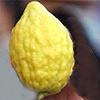Citron is a small and thorny evergreen tree. Its thorns are short and rigid. Its fruit is used in the Sukkoth ritual, which is its main usage. The leaf is lanceolate, 15 cm long, its margin is dentate.
Citrus medica blooms in the spring and summer months. The flower is white on the inside, pink or purple on the outside. There are numerous stamens, 30 or more. The shape and structure of the flower is similar to that of other citruses.
The fruit is juicy, divided into slices, and each slice contains juice saccules. The size of the fruit is between a lemon and an orange. It has an elongated ovate shape, narrowing towards a protruberance (which is a remnant of the style). The fruit peal is scabrous, yellow, thick and fragrant. The pulp is very limited compared to other citrus fruits, sour and not tasty. The pulp and the peal are used for making jam and sweets, as well as for cosmetics. However, the citron’s main use is religious.
This is the first citrus tree that came to the Middle East, apparently already 6000 years ago. Its origin is unknown, perhaps from India or from southern Arabia. It was perhaps brought to the Land of Israel from Madai (Iran) by immigrants from Babylonia during the time of the Second Temple, and was identified with the biblical plant “boughs of goodly trees” (Leviticus 23: 40), which is among the 4 kinds that are customarily used for blessings on Sukkoth. The citron became a customary symbol in Jewish art since the days of the Mishnah.
In the scientific classification citruses are regarded as a genus or group of genera in the Rutaceae family, and the citron is one of the species in this group.
Written by Mike Livne






